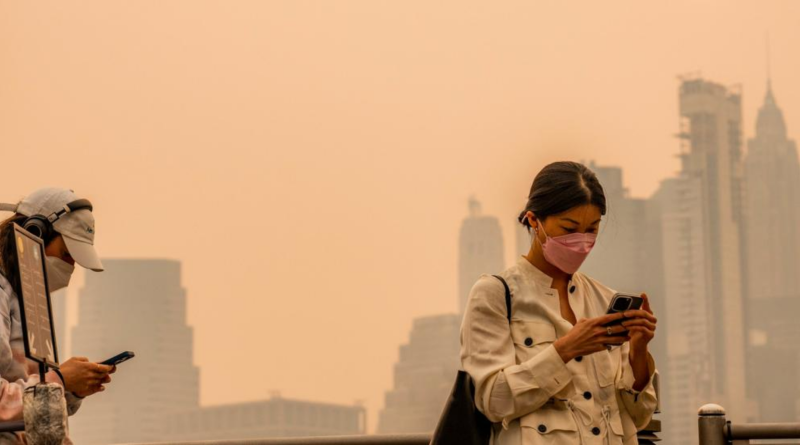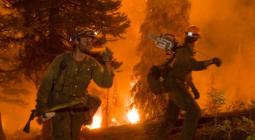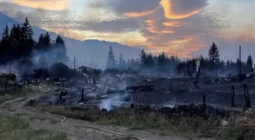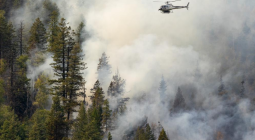
5 Ways Wildfires Affect People Near and Far

Cover Image by: Anthony Quintano/Flickr
As wildfires become more frequent and more severe worldwide, people near and far are increasingly feeling their impacts.
In June 2023, wildfires in Quebec caused more than 75 million people in the United States to experience unhealthy or hazardous air quality, and smoke was seen as far away as southwestern Europe. On a still larger scale, recent research suggests that smoke emissions from Australia’s bushfires in 2019-2020 may have helped trigger a rare, three-year La Niña event that shifted weather patterns on continents around the world.
It’s also a problem that’s worsening. Although wildfire is an important ecological process in many forest ecosystems, and prescribed burns can be an effective forest management tactic, declining forest health, climate change, and development in areas with high fire risk are causing wildfires to become catastrophic. According WRI’s Global Forest Watch platform, forest fires are burning nearly twice as much tree cover today as they did 20 years ago.
The devastation of these wildfires makes it clear that their effects extend far beyond the forest itself. While poor air quality and scorched earth are a fire’s most visible impacts, wildfires affect people, the environment and even cities in multiple ways — from harming economies to heightening flood risks.
Here are five examples of how wildfires affect people hundreds or even thousands of miles away:
1) Wildfires Can Create Hazardous Air
As the recent fires in Quebec illustrated, wildfires can have far-reaching impacts on air quality, with wind pushing smoke across hundreds of miles and causing widespread health hazards. The fine particles in wildfire smoke pose the biggest threat to human health: They can cause burning eyes, respiratory illnesses like bronchitis, and aggravated symptoms for people with chronic heart or lung conditions.
Smoke is not the only way fires impact air quality. Recent research shows that wildfires can cause “dust enhancement,” creating substantial dust storms that may last days, or even weeks, over normally dust-free regions. These storms can negatively affect human health, causing respiratory damage much like smoke does, as well as damage infrastructure and ecosystems.
As fires grow in size and frequency, so do the risks. For example, over 69 million people in Equatorial Asia experienced persistent exposure to unhealthy air quality caused by wildfires in 2015; scientists estimate this may have caused about 12,000 deaths. And 1 in 7 Americans experienced dangerous air quality in 2020 due to wildfires.
2) Wildfires Fuel Climate Change
In addition to creating poor air quality, wildfires produce planet-warming greenhouse gases that fuel climate change. Because trees store carbon, they also release it into the air as they burn. In 2021 alone, wildfires in boreal forests across North America, Europe and Asia released 1.76 billion tons of carbon dioxide. Ranked as a country, this would put wildfire in the world’s top-ten biggest emitters.
After a wildfire concludes, some of this carbon will be recaptured as the forest recovers. But the loss of trees reduces a forest’s ability to capture and store carbon for many years. Given that forests absorb a net 7.6 billion metric tonnes of carbon dioxide per year — roughly 1.5 times the United States’ annual emissions — large forest losses can worsen the climate crisis.
3) Wildfires Threaten Water Security
Forests are vitally important for safeguarding water quality and freshwater access. Forested watersheds provide over two-thirds of the world’s drinking water, with 33 of the world’s 105 largest cities relying on forested areas for their water supplies alongside many smaller cities and rural regions.
Forests and trees increase infiltration and reduce rates of erosion, both of which prevent sedimentation and other pollutants from reaching rivers and lakes crucial for water supplies. After a wildfire there are fewer trees to intercept water runoff from storms, and soil becomes unstable and more prone to erosion. This means that when it rains, more sediment, ash and pollutants end up flowing into lakes, rivers and reservoirs. After the 2018 Camp Fire in California, for example, post-fire rainstorms caused debris and toxicants to enter nearby bodies of water, and some utilities had to stop using water from sources too close to the fire.
Additionally, forested watersheds can help recharge groundwater and ensure consistent water supplies year-round. Trees in a forest store and release water vapor, which can regulate weather and rainfall. The canopy and roots of trees can also help slow the flow of runoff, releasing water into downstream systems more gradually. Catastrophic wildfires cause losses in the forest canopy and affect the soil underneath it, which can disrupt these water-regulating systems and deplete freshwater supplies in areas which rely on forested watersheds.
4) Wildfires Can Increase the Risk of Flooding
Cities are especially susceptible to flooding. Urban areas have high amounts of impermeable surfaces, such as sidewalks and roads, which results in more runoff when it rains. Healthy forests near cities can act like sponges, increasing infiltration into soil, storing excess runoff and slowing water down. In other words, they serve as barriers that protect downstream cities from floods.
When heavy rainfall happens in an upstream forest after a wildfire, there is no tree canopy to slow down the water and the soil is less able to store runoff. As a result, flash floods can happen with even relatively small amounts of rainfall. For example, in Mora County, New Mexico, flooding after the Hermits Peak-Calf Canyon fire brought ash, water and sediment that damaged countless homes. The floods also led to power outages which caused rural farmers to lose cattle and game meat, and clogged many of the canals on which the area relies for water access — both of which have affected the livelihoods of community members.
This is not a short-term issue: It can take years for vegetation to grow back after a wildfire, leaving cities and other communities at risk for just as long.
5) Wildfires Can Cause Direct and Indirect Economic Losses
Each of these impacts can result in negative economic effects:
- Air quality: The health effects of wildfire-induced air pollution can carry significant medical costs. In the United States alone, the health impacts of wildfire smoke cost $16 billion annually.
- Water quality: If a watershed that a city depends on is affected by wildfire, the city may need to pay for water treatment in that watershed and/or water shipments from other sources. After a large wildfire, the cost to produce drinking water can increase by $10 million to $100 million.
- Flood risk: Flooding can damage infrastructure, disrupt supply chains and leave people needing medical care. Under business as usual, flood-related economic losses could total $1 trillion globally by 2050.
Wildfires can also reduce economic activity. Australia’s bushfires may have cost the nation’s tourism industry as much as $4.5 billion between 2019-2020. More recently, the devastating wildfires in Maui, Hawaii drove economic losses of about $9 million per day, heavily impacting local livelihoods. And it’s not just the travel industry that feels the squeeze: Many small-town economies rely on tourism to stay afloat, and sustained fire threats can cause long-term business closures, putting jobs and income at risk.
What Can Cities and Communities Do to Keep Forests Healthy and Help Prevent Wildfires?
While city residents may be located hundreds of miles away from forest fires, they are not powerless to do something about them. By making forests more resilient to wildfires, cities can protect their communities. Here are a few ways they can act:
- Cities can become anchor investors in restoration projects across state, federal and privately managed lands. For example, the Forest Resilience Bond, a financing model developed by Blue Forest Conservation, WRI’s Cities4Forests and other partners, is already financing ecological restoration across 48,000 acres of the Tahoe National Forest to mitigate wildfire risk. This includes things like fuel reduction to prevent future fires, tree restoration in areas already affected, and removing invasive species in the area to promote forest health.
- City agencies, such as water utilities, can dedicate resources and workforce capacity to support wildfire resilience and restoration. As recently observed post-wildfire in Marion County, Oregon, many work opportunities for restoration are seasonal, inconsistent, underpaid and require technical expertise. As a result, when a wildfire occurred, labor resources were directed to fire suppression and recovery efforts. This short-term and sporadic approach results in limited resources that get split between pre-fire resilience and post-fire recovery, preventing either from getting enough dedication to be effective. City agencies can help fill these gaps with dedicated, year-round staff focused on restoration activities.
- Cities can help higher-risk communities become resistant to wildfires. In the United States, more than 60,000 communities live in areas classified as “wildland-urban interfaces.” These transition areas between unoccupied land and human development are often filled with underdeveloped wildland and vegetation that can provide fuel for wildfires. Cities can play a role in hardening communities against wildfires, especially if they exist within these kinds of higher-risk areas.
- Cities can take greater action against climate change. Climate change is creating hotter, drier conditions worldwide that allow wildfires to catch and spread more frequently and intensely. Given that cities account for 70% of the world’s carbon emissions, they hold a significant responsibility to take climate action. This, in turn, can prevent wildfire risk from continuing to increase while also generating myriad economic opportunities. Research from the Coalition for Urban Transitions found that cutting urban emissions by 90% by 2050 would yield almost $24 trillion in economic benefits.
Despite the smoke clouding many cities, the path forward is clear to see. Cities have much to gain from wildfire resilience, and they have a unique vantage point to get money flowing toward mitigation and resilience projects. Now is the time to see whether recent air quality scares will serve as the wake-up call needed to move cities to action.





